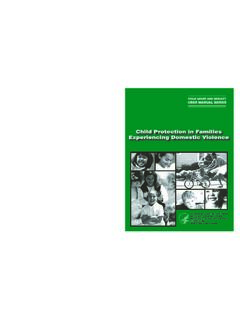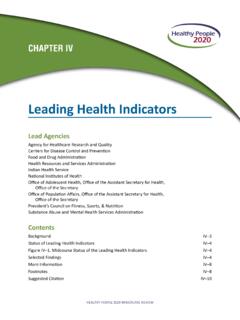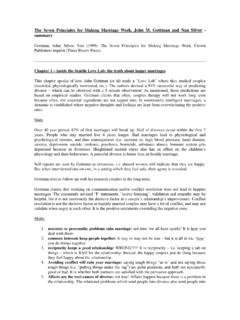Transcription of THE BEHAVIOURAL DRIVERS MODEL - UNICEF
1 THE BEHAVIOURAL DRIVERS MODELTHE BEHAVIOURAL DRIVERS MODELA CONCEPTUAL FRAMEWORK FOR SOCIAL AND BEHAVIOUR change PROGRAMMINGThe BEHAVIOURAL DRIVERS MODEL : A Conceptual Framework for Social and Behaviour change ProgrammingAuthor: Vincent Petit, Communication for Development Regional Advisor, UNICEF Middle East and North Africa The development of the framework has benefited from the contributions of UNICEF staff, in particular Line Baago-Rasmussen, Helena Ballester Bon, Alessia Radice, Violeta Cojocaru and Rafael Obregon. The synthesis of decision-making and BEHAVIOURAL theories and models was conducted with the support of the University of Pennsylvania, Social Norms Group (PENN SoNG), under the leadership of Andr s Casas Casas and with contributions by Tung Bui, Douglas Paletta and Peter McNally. Interactions with The Learning Collaborative to Advance Research and Practice on Normative change for Adolescent Sexual and Reproductive Health were instrumental in identifying and discussing improvements.
2 We are grateful to all the participants from UNICEF country offices and their partners in government agencies, non-governmental organizations and other United Nations and international aid agencies that shared their expert feedback during the pre-testing exercises in Egypt, Lebanon, Senegal, Sierra Leone, Uganda and Zimbabwe, as well as contributions from citation: Petit, V. (2019). The BEHAVIOURAL DRIVERS MODEL : A Conceptual Framework for Social and Behaviour change Programming. UNICEF . United Nations Children s Fund ( UNICEF ), 2019 For further information, contact: UNICEF Middle East and North Africa Regional OfficeCommunication for Development Box 1551. Amman 11821, JordanWebsite: and layout by QUOWhy this publication? Despite the insights that models can provide to explain and sometimes predict behaviours, their application by social and behaviour change practitioners remains very limited.
3 Theoretical foundations of BEHAVIOURAL strategies and interventions are often implicit rather than explicit (Sood and Cronin, 2019). There is a need to make BEHAVIOURAL models more practical and attractive to those who are supposed to use them in real life, filling this operational gap. Implementation science flags that most theories address barriers and enablers but provide limited how-to support for selecting relevant approaches to influence them (Nilsen, 2015). Others suggest approaches to guide implementation, but these are not directly and rigorously linked to the constructs that were used to build the models. One of the consequences of this discontinuity between theory and practice is the frequent resorting to go-to default interventions, such as trying to solve any BEHAVIOURAL issue with a communication campaign, regardless of what may explain the practice of the behaviour.
4 This brings into question the appropriate use of already limited resources, and the potential for programmes to have an impact. To increase the uptake of theory by programme designers, we need to address two essential questions: 1. Why do people do what they do? 2. How do we influence what they do? In this document, we will try to make the explanation of complex phenomena more accessible, and systematically link every conceptual element to an approach that can influence it. In doing so, we hope to simplify the use of our MODEL so that it falls into the useful category described by George Box s above aphorism. What is this publication? This Conceptual Framework for Social and Behaviour change Programming gathers in one place a wide variety of theories and presents the BEHAVIOURAL DRIVERS MODEL which informs a set of research and programming tools recently developed and used by UNICEF , including Everybody wants to belong: Practical guide to tackling and leveraging social norms in behavior change programming and Measuring Social and BEHAVIOURAL DRIVERS Guidance Tool.
5 It offers a common reference and language for the study and practice of social and behaviour change (SBC), and can be used as a basis to conduct participatory situational assessments, design and operationalize strategies and programmes, monitor the extent to which interventions are being implemented, and evaluate effectiveness and changes in BEHAVIOURAL and social outcomes. It is part of a larger effort to promote evidence-based programming and guarantee the highest standards of SBC practice as a means to attain sustainability and impact in the protection and promotion of children s and women s rights. The document begins by presenting the goals and core ideas of the framework; then explores how this conceptual framework ties together theories of change through the BEHAVIOURAL DRIVERS MODEL ; and concludes by explaining how the MODEL can guide operationalization through programme design, selection of field interventions and with other applied theories, this conceptual framework is a living document that the wider community of allies and SBC partners can appropriate and help expand in a process of shared MODELS ARE WRONG, BUT SOME ARE USEFUL George BoxCONTENTSA cronyms and viPart I.
6 WHY USE A CONCEPTUAL FRAMEWORK FOR SOCIAL 1 AND BEHAVIOUR change ? 1. General 2 2. Goals of the 2 3. Audience and intended 4 Part II. DESCRIPTION OF THE CONCEPTUAL FRAMEWORK 5 4. Filling the theoretical 6 5. What drives us?.. 6 6. A synthesis of decision-making and 9 theories and models 7. The BEHAVIOURAL DRIVERS 19 Nature of the MODEL and core structuring 19 The main BEHAVIOURAL factors (Level 1 DRIVERS ).. 20 20 22 23 BEHAVIOURAL DRIVERS MODEL Level 25 Assumptions and 25 Unpacking further into dimensions (Level 2 DRIVERS ).. 28 Cognitive 29 31 32 34 Limited 36 Social 38 Community 40 41 Communication 43 Emerging 44 Governing 45 Structural 46 From intent and action to a new 47 Personal characteristics and contextual 48 The full map: BEHAVIOURAL DRIVERS MODEL Level 49 8.
7 Connections of the BEHAVIOURAL DRIVERS MODEL to 52 Socio-Ecological ModelPart III. THE BEHAVIOURAL DRIVERS MODEL AND ITS 55 APPLICATIONS FOR SOCIAL AND BEHAVIOUR change PROGRAMMING 9. The applied logic of the MODEL for social and behaviour 56 programming 10. How the MODEL can guide programme design and selection 59 interventions Part IV. CONCLUSION 71 Bibliography .. 74 THE BEHAVIOURAL DRIVERS MODELviBDM BEHAVIOURAL DRIVERS ModelCBO community-based organizationCSO civil society organizationECD early childhood development FBO faith-based organizationFGM female genital mutilationHCD human-centred design HRBAP human rights-based approach to programming IPV intimate partner violenceNGO non-governmental organizationSBC social and behaviour changeSEM Socio-Ecological MODEL UNFPA United Nations Population FundUNICEF United Nations Children s FundUSAID United States Agency for International DevelopmentACRONYMS AND ABBREVIATIONSWHY USE A CONCEPTUAL FRAMEWORK FOR SOCIAL AND BEHAVIOUR change ?
8 PA RTITHE BEHAVIOURAL DRIVERS MODEL2To maximize its chances of success, any effort to diagnose and analyse what drives a behaviour, design effective interventions targeting those DRIVERS , and measure the achievements of such interventions in the field should begin with a conceptual framework of behaviour change followed through the applied advances in BEHAVIOURAL and decision sciences (World Bank, 2015) and the evidence gap that persists among international aid operations and practice in the field (Learning Collaborative, 2018) highlight improvements and challenges, respectively, to the study and practice of social and behaviour change . It remains necessary to build bridges between different viewpoints in related fields of study (sociology, anthropology, psychology, BEHAVIOURAL sciences, communication studies, economics, marketing, political science and development studies) using a shared theoretical but field-oriented tool that can help advance clarity and congruence in the design, implementation, monitoring and evaluation of BEHAVIOURAL interventions.
9 This will contribute to enhancing the analytical capacity, rigor and sensitivity needed to understand a wide and diverse set of behaviours in their contexts. It will also serve an increasingly heterogeneous set of participants engaging in development and rights-promotion activities on the ground (Learning Collaborative, 2018), who might not always be equipped to grasp the complexity of social and BEHAVIOURAL meet these objectives, the following conceptual framework (henceforth, framework) builds on a comprehensive, rigorous and empirically grounded account of BEHAVIOURAL DRIVERS . It reviews dominant theories of social and behaviour change (SBC), synthetizing key insights and gathering empirically significant constructs to develop a transtheoretical MODEL that can guide pathways for a better are three goals that guide the development of this framework: First, it serves to provide a common reference and language for the study and practice of SBC.
10 A comprehensive taxonomy and suggested methodology will assist researchers and practitioners alike in developing tools for change , interacting and maintaining a level of conceptual rigor throughout their work. Second, the framework provides guidance on how to operationalize the BEHAVIOURAL DRIVERS MODEL , linking SBC theory to practice while assessing and influencing a wide range of DRIVERS . It also suggests the kind of tools that may be relevant to this goal. Third, the framework aims to contribute to the toolbox of UNICEF s teams and SBC practitioners by complementing the Socio-Ecological MODEL that orients UNICEF s work PURPOSEGOALS OF THE FRAMEWORK12A CONCEPTUAL FRAMEWORK FOR SOCIAL AND BEHAVIOUR change PROGRAMMING3 Because of the complexity of the field and suboptimal standards of practice still observed, the second goal, which is centred on operationalization, is the most important one.
















